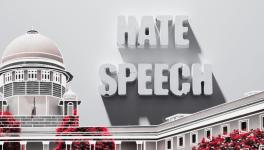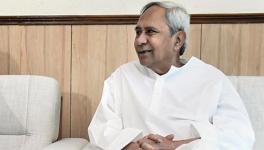Amit Shah’s Epitaph for Delhi Communal Carnage

Image Courtesy: The Indian Express
Over two weeks after the communal carnage in Delhi, home minister Amit Shah delivered a lengthy epitaph on it in Parliament on March 11. He was replying to a debate on the horrific violence during February 23- 26 that shocked the Capital – and the world – for its brutality and scale.
Although confined to a densely populated belt of working class and middle class localities in North-Eastern Delhi, the loss of 53 lives and injuries to over 200 people, as also the widespread destruction of homes, shops, vehicles, schools, and religious places showed that it was not just a riot but full scale carnage, carried out with a range of weapons and chilling targeting. Since Delhi Police is under Shah’s jurisdiction, it was fitting that he should be responding to the debate.
But, with breath-taking boldness, the home minister and former BJP president defined an alternative narrative which avoided all troubling questions about what led to the carnage, what was its nature, why security forces did not prevent it, and so on.
Shah’s statement in Parliament defined the whole thing as manufactured by Opposition parties who gave hate speeches, misled the minority community, and he described the violence in symmetrical terms – both communities suffered. He also assured speedy and effective action against rioters.
In a telling manner, Shah took the high moral ground in describing the 53 dead and 526 injured as “Indians” refusing to say which communities they belonged to. While this may appeal to many, but sometimes the bitter truth is needed – only then can real change take place.
The bitter truth is that out of the 48 dead about whom details have been reported, 39 are reportedly from the minority community and the rest (9) from the majority community. This single fact shows the nature of this carnage. So, not revealing this in the name of all being “Indian” is a sleight of hand, not patriotic humanity.
Why is this an inversion of truth? Why is this an alternative narrative? And, why at all does he indulge in this? Let us look at some examples and it will become clear.
Role of Police
One of the most serious and well documented issues that baffled people was that not only did Delhi Police not move in fast enough but in many videos now available, some of them are seen helping the violent mobs associated with Bharatiya Janata Party, or in one barbaric case, beating wounded youth and forcing them to sing the national anthem. One of these men later died after police delayed taking him to hospital, according to reports.
It has also been reported that policemen were seen helping a mob vandalise the Farooquia Mosque in Mustafabad, as described by local people. There are also reports of policemen beating up women protesters and hurling rank communal and vulgar abuses on them on the first day itself.
It took three days for sufficient security forces to be deployed in the whole belt. Till then, the violence had taken a mind-boggling toll of life and property.
Shah glossed over all this and praised the police for containing the violence within a relatively small area and controlling it within 36 hours. He totally avoided any explanation for why police/security forces were not deployed at the outset, despite intelligence reports saying that trouble was brewing. Why thousands of distress calls went unanswered. It happened under his watch, he himself claimed that he was sitting with police officials throughout monitoring the events. Yet no preventive action was ordered.
Subsequently, Shah again pats the police on the back for arresting over 2,600 people on charges of rioting etc. and the registering of 700 FIRs. He does not reveal that the police has refused to reveal the names of those arrested despite the clear judicial guidelines that all FIRs should be displayed on notice boards at police stations. In fact, a petition is pending in the High Court asking for names. Anecdotal reports suggest that a majority of those picked up and charged belong to the minority community – but in the absence of official statements, there is uncertainty on this.
Clearly then, police has not been fair and impartial. It has either stood back or even been complicit, as per reports. Yet Shah is praising them. Will this create confidence among the victims? Will this bridge the communal divide?
Whose Hate Speeches?
Another major inversion done by Shah in his Parliament speech was to dismiss the well documented speeches by BJP leaders that called for shooting traitors or alleging that minority community will invade homes and rape women, and kill everybody. He said in his speech that allegations of hate speeches are being probed.
Then he went on to describe what he thought were the real hate speeches. He said that Congress leaders gave hate speeches on December 14 at a rally calling upon people to come out because it is a’ do or die’ battle. With this, the home minister not only sought to build the version that it was really the Opposition that incited violence but more significantly, he thus blamed the minority community for the violence.
Forgotten were the hate speeches of Anurag Thakur (a minister in the Modi government) and Parvesh Verma (a BJP MP from Delhi). Forgotten was the infamous Kapil Mishra speech standing next to a senior police official, threatening to take action against anti-CAA protesters – which is widely perceived as the spark that set off the incendiary violence.
In fact, it was Shah himself who set the stage by leading and managing the BJP campaign for Delhi’s Assembly elections, held two weeks before the communal carnage erupted. This campaign saw a relentless barrage of poisonous and divisive speeches including the ones by Thakur and Verma. But that too is forgotten. Shah’s story has worm-holed into a parallel universe.
Does this instil confidence among people who were severely affected by the violence? Does it build bridges? Doesn’t it create impunity among violent mobs affiliated to the BJP and Saffron Brigade to attack minorities?
Technology as Saviour
Shah, in his speech, was full of pride at the fact that 1922 “rioters” had been picked up by the police after images from police videos and social media were matched with voter ID and driving license databases using facial recognition technology.
To underline the significance of this, he said that 40 teams worked on this task. They even trawled databases from four adjoining districts of Uttar Pradesh. Then, he stated that since technology doesn’t recognise religion, this was an ‘impartial’ exercise.
But as experts from many countries have often pointed out, facial recognition technologies are very imprecise. In some cases, as much as four-fifths of matches were found erroneous. Besides, if people were wearing masks, helmets or had tied a cloth around the face, nothing can be inferred. Videos show that a large number of people were wearing helmets and masks.
Yet, Shah and his 40 teams claim to have achieved this phenomenal feat. Is there any corroborating evidence? Is there any caution that technology may not be accurate?
And then, ground reports suggest that indeed a larger proportion of minority community members are being picked up. This is not to argue that there was no violence by the minority community. Indeed, there was, especially on the first day. But, as Shah asserted – money from abroad poured in, Opposition parties incited the minority community, they were misled into opposing CAA, etc. So, the narrative is decisively inverted to portray the whole thing in reverse.
What Amit Shah has done is to deftly – and sometimes quite crudely – transform the Delhi carnage into a riot, and then to a riot instigated and carried out by the minority community. And, simultaneously, he and the BJP-led government are shown as diligent, proactive and fair, yet firm in dealing with such rioters.
Such is the epitaph Shah has devised.
Get the latest reports & analysis with people's perspective on Protests, movements & deep analytical videos, discussions of the current affairs in your Telegram app. Subscribe to NewsClick's Telegram channel & get Real-Time updates on stories, as they get published on our website.
























